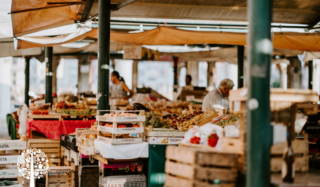Online shopping has taken over, and yes, farmers’ markets are part of the virtual world, too! Already a burgeoning idea before the pandemic, they instantly became popular as an alternative for growers and customers during the early phase of the worldwide lockdown when access to in-person markets was restricted. Since then, they’ve continued to grow in number and have made supporting local growers and buying local and fresh produce easier than ever before.

What is a virtual farmers’ market?
Farmers sign up to become part of an online portal, like registering with a farmers’ market association to sell products at traditional markets.
Market managers coordinate the online portal, vendors, and communications with customers in the same way a manager coordinates your local farmer’s market.
Farmers are charged a small vending fee, with all direct sales from their online produce going straight to them.
As with the traditional farmers’ market, a virtual farmers’ market operates within a defined geographic area for vendors and customers; this does not mean you cannot shop at a market outside your geographic location. Just be prepared to pick up your purchases instead of having them delivered.

Most growers participating in online farmers’ markets operate small to mid-size farms. These farms sometimes struggle to compete with larger operations. An online market gives them an equal market share as all are promoted equally through the portal.
How does ordering work?
As with a traditional farmers’ market, the market is only open on specific days throughout the growing season. The market manager will notify registered customers that sales are open.
Let’s say the market starts on Sunday and closes on Tuesday. Between that time, you can place whatever items you like in a virtual shopping cart, pay for them, and guarantee they are held. Payment is made online through a credit card.
Delivery or pick-up options are within a week of purchase – guaranteeing produce arrives fresh.
It’s not the same as a CSA box subscription!
It is easy to confuse a virtual farmers’ market with a community-supported agriculture (CSA) subscription. Although both support local growers and provide the customer with fresh local produce, they’re not the same. A CSA subscription is prepaid with items selected by the grower. A virtual online farmers’ market lets you choose your desired amount and produce varieties.
Do some homework
Although vendors at a virtual farmers’ market are vetted the same as traditional marketplaces, it pays to do some homework.
Check certification. For example, does the grower have an organic certification, or have they been a member of a farmers’ market association in the past?
Do some price comparison and check out different vendors to get the best value, as you would at a regular market.
Does the farmers’ market have an app? Some do, and that can make shopping and notifications easier.
Does the market deliver, or will you have to pick up your purchases?
How to find an online farmers’ market

Because new markets are constantly coming online, current lists of those operating in your area may be sparse. Check with your local farmers’ market association; they can point you in the right direction.
Open Food Network (openfoodnetwork.ca) is an excellent place to search in Canada.
The Farmers Market Coalition (farmersmarketcoalition.org) also offers valuable resources in the United States.
Happy online shopping!